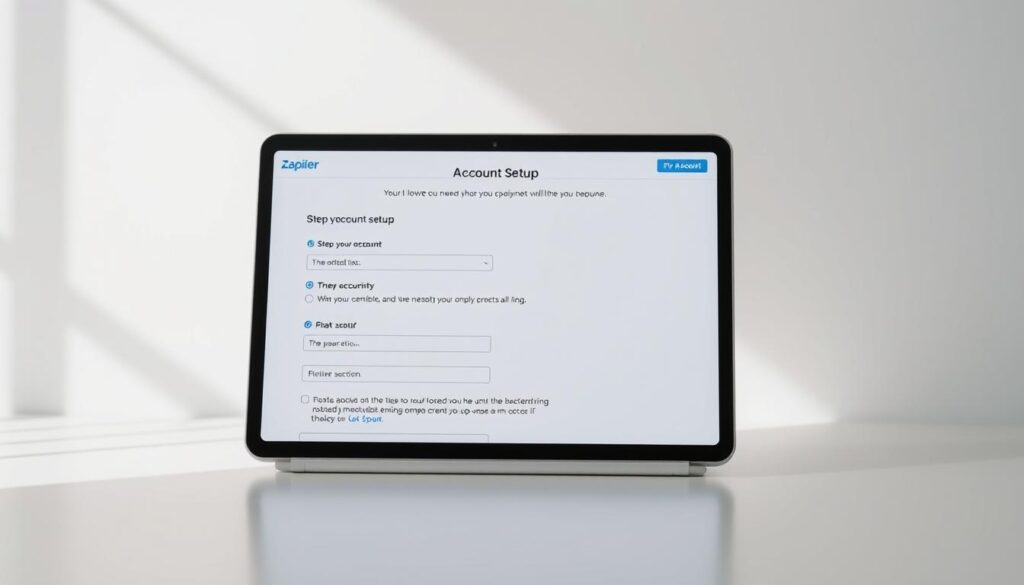Did you know that businesses waste 20% of their time on repetitive tasks? Automation can change that. With tools like Zapier, you can streamline your workflows without writing a single line of code.
Zapier is a no-code platform that connects over 3,000 apps, making it easier to automate tasks. Whether you’re managing emails or scheduling social media posts, it saves time and boosts efficiency.
For businesses, automation means less manual work and more focus on growth. You can create workflows that handle data transfers, notifications, and more. It’s simple, fast, and requires no technical skills.
In this guide, we’ll walk you through creating your first workflow, or “Zap,” step by step. Ready to save time and simplify your tasks? Let’s dive in!
Key Takeaways
- Zapier is a no-code automation platform for businesses and individuals.
- Automation saves time by streamlining repetitive tasks.
- Connect over 3,000 apps without technical skills.
- Real-world use cases include email management and social media scheduling.
- Learn how to create your first workflow with a step-by-step guide.
Introduction to Zapier: Your Gateway to Automation
Imagine a world where your tools work seamlessly together. This is the power of automation. A workflow automation platform connects apps and services, eliminating manual tasks and boosting productivity.
At its core, this platform uses triggers and actions to create multi-step workflows. Triggers start the process, while actions complete the tasks. This system ensures smooth data movement between apps.
What is Zapier?
Zapier is a web-based platform that connects over 3,000 apps. It allows users to automate tasks without coding. From inventory management to sales tracking, it simplifies complex workflows.
Why Use Zapier for Automation?
Small businesses benefit greatly from this tool. It reduces errors and saves time by automating repetitive tasks. The dashboard provides total visibility into connected apps and data movement.
Compared to manual workflows using spreadsheets or multiple tools, automation is faster and more efficient. It’s a game-changer for teams looking to focus on growth rather than mundane tasks.
Getting Started with Zapier
Automation starts with a simple step: setting up your account. Whether you’re a solo entrepreneur or part of a team, this process is quick and straightforward. Let’s walk through the essentials to get you up and running.

Creating Your Zapier Account
To begin, visit the platform’s website and sign up for a free account. You’ll need to provide basic details like your email and password. Once registered, you can explore the free plan or upgrade to a paid option for advanced features.
Choosing the right plan is crucial. The free plan is ideal for beginners, while paid plans offer more tasks and premium integrations. Always review the billing cycles and renewal policies to avoid unexpected charges.
Navigating the Zapier Dashboard
The dashboard is your command center. Here, you’ll find sections like Zaps, History, and App Connections. These tools help you manage workflows, track activity, and connect apps seamlessly.
Security is a top priority. The platform uses SOC 2 compliance and data encryption to protect your information. Enable two-factor authentication for an extra layer of privacy.
For teams, managing access is simple. You can assign roles and permissions to ensure everyone has the right level of control. This keeps your workflows secure and efficient.
By understanding these features, you’ll be ready to automate tasks like a pro. Start small, explore the tools, and watch your productivity soar.
Creating Automated Workflows with Zapier
Streamline your daily operations with simple automation steps. At the heart of this process are Zaps, the building blocks that connect apps and automate tasks. Understanding how they work is key to unlocking efficiency.
Understanding Zaps: The Building Blocks of Automation
A Zap consists of three main components: the Trigger app, the Action app, and data mapping. The Trigger app starts the workflow, while the Action app completes the task. Data mapping ensures information flows seamlessly between apps.
Step-by-Step Guide to Creating Your First Zap
Let’s walk through creating a Slack-to-Google Sheets notification system. First, choose Slack as the Trigger app and set it to detect new messages. Then, select Google Sheets as the Action app to log these messages automatically.
For email automation, connect Gmail to your CRM platform. Set Gmail as the Trigger app for new emails and your CRM as the Action app to update customer records. This setup is perfect for sales and marketing teams.
Here’s how to handle errors and test your Zaps:
- Run test workflows to ensure data flows correctly.
- Check for errors in the Zap history section.
- Adjust data mapping if needed for accuracy.
For e-commerce, use Zap templates to update product listings automatically. This ensures your inventory stays current across platforms.
Finally, automate social media post scheduling by connecting your calendar to platforms like Facebook or Twitter. This saves time and keeps your marketing efforts consistent.
Managing and Optimizing Your Zapier Workflows
Effective workflow management requires consistent monitoring and optimization. Keeping your automation processes running smoothly ensures maximum efficiency and minimizes disruptions. Here’s how to stay on top of your workflows and implement best practices for long-term success.
Monitoring and Troubleshooting Your Workflows
Regularly check your workflow history logs to monitor data flow and identify errors. These logs provide details on task statuses, helping you spot issues early. If a task fails, follow these troubleshooting steps:
- Review the error message for specific details.
- Test the workflow to ensure data mapping is accurate.
- Adjust settings or reconnect apps if necessary.
For high-priority workflows, create a daily list of tasks to check. This ensures critical processes run smoothly and reduces the risk of missed deadlines.
Best Practices for Efficient Automation
Documenting your workflows is essential for team support. Outline the purpose, setup steps, and troubleshooting tips for each process. This keeps everyone informed and reduces dependency on a single person.
Be cautious about automatic renewals and billing practices. Monitor subscription details to avoid unexpected charges. Regular audits of connected apps and permissions also enhance security and efficiency.
Save time by using bulk editing and templates. These tools streamline workflow management and make it easier to scale your automation efforts. For example, Zapier’s built-in monitoring tools can help you track performance and resolve issues quickly.
| Practice | Benefit |
|---|---|
| Daily Checklists | Ensures high-priority workflows run smoothly |
| Documentation | Provides team support and clarity |
| Regular Audits | Enhances security and efficiency |
| Bulk Editing | Saves time and simplifies workflow management |
Conclusion: Streamline Your Workflow with Zapier
Businesses can achieve remarkable efficiency by automating repetitive tasks. Tools like Zapier transform manual spreadsheet work into seamless workflows, saving valuable minutes that add up daily. Start small with simple automations, such as website-to-email notifications, to see immediate benefits.
For larger teams, investing in team training ensures everyone can leverage automation effectively. Gradually expand from basic tasks to complex multi-app services to maximize productivity. Always review platform policies alongside technical setup to avoid surprises.
By integrating tools like Zapier, businesses can focus on growth rather than mundane tasks. Start today and watch your workflows become faster, smarter, and more efficient.
FAQ
What is Zapier?
Zapier is a platform that connects apps and services to automate workflows. It allows you to create automated tasks, called Zaps, without needing to write code.
Why should I use Zapier for automation?
Zapier saves time by automating repetitive tasks. It integrates with thousands of apps, making it easy to streamline workflows, manage data, and improve productivity.
How do I create a Zapier account?
Visit the Zapier website and sign up using your email or Google account. The process is quick and free for basic plans.
How do I navigate the Zapier dashboard?
The dashboard is user-friendly. It includes sections for creating Zaps, managing workflows, and accessing tools like task history and app integrations.
What are Zaps in Zapier?
Zaps are automated workflows that connect apps. Each Zap consists of a trigger (an event that starts the workflow) and an action (the task performed).
How do I create my first Zap?
Start by selecting a trigger app and event. Then, choose an action app and define the task. Test your Zap to ensure it works correctly.
How can I monitor and troubleshoot my Zaps?
Use the task history feature to track Zap performance. If issues arise, check the error logs and adjust settings as needed.
What are the best practices for efficient automation?
Keep workflows simple, use filters to avoid unnecessary tasks, and regularly review your Zaps to ensure they align with your goals.
I’m into tech, trends, and all things digital. At CrazeNest, I share what’s new, what’s next, and why it matters — always with a curious mind and a creative twist.





